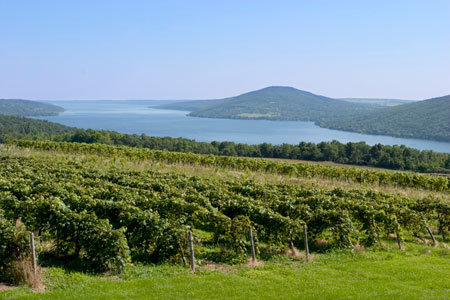America’s Wine Renaissance
by Natasha Wolff | December 11, 2013 3:09 pm
Historically, New World wines—particularly those produced in the U.S.—have struggled to achieve the same prestige as their Old World counterparts. Wines from California are characteristically written off as being too oaky, overly alcoholic and overpriced; East Coast wines are often considered too jammy, sweet and unsophisticated. But now a handful of new statistics prove that America’s wine industry is actually stronger and more successful than ever.
A recent report from Morgan Stanley found that wine production in the U.S. is up 20 percent[1], and according to research firm Nielsen, wine revenues in America are rising faster than volumes—meaning consumers are purchasing more expensive bottles.
Have domestic wines suddenly begun to defy their previous stereotypes? We asked four prominent wine industry experts for their opinions.
Our experts:
Sara Kavanaugh, Sommelier
The Grill Room
New Orleans, Louisiana
Rajat Parr, Wine Director
Michael Mina 74[2] and Michael Mina Restaurants
Various locations
Grant Reynolds, Sommelier
Charlie Bird
New York City
Joel Burt, Winemaker
Chandon Wines
Napa Valley, California

Canandaigua Lake in the Finger Lakes Region of New York State
Why do you think that domestically wine production is increasing the way it has been?
Grant Reynolds: Consumers and wine drinkers as a whole are now younger and much more adventurous. Also, a couple of regions have popped up that people are just now discovering—new areas of wine production outside of the classic Napa Valley stuff.
Joel Burt: There are a few reasons. For one, we had several years with very low yield and also a lack of investment in vineyards because of the recession, but recently people have been really investing in vineyards. We have more supply and it’s coming in just at the right time when there’s also greater demand. The other reason is that winemakers are expanding into other regions. Chandon[3] is based in Napa, but there’s only so much land you can grow grapes on in Napa Valley. So we’re moving into other appellations going forward.
What are some of the misconceptions people have about U.S. wine?
JB: People says that California Chardonnay is oaky and buttery with high alcohol content, but it’s not really like that anymore. There are plenty of producers making wines that are interesting and balanced and don’t have that grotesque treatment of oak and sugar.
When do you find yourself suggesting domestic wine to guests?
Sara Kavanaugh: If they want something round, opulent, lush and silky, I’d go with domestic. Because the acids are low, the wines are really great to drink without food. Acid can be scary to guests, so with low acid wines like those produced in the U.S., you don’t really need food to go with it. I call it my “front porch” wines—you can just sit and drink and relax and not have to feel that structure on your palate.
In your opinion, what are the most unlikely up-and-coming wine regions?
SK: I really like Willamette, Oregon. They’re still young in the game and they’re still going through lots of changes. The Finger Lakes in New York are pretty exciting. They have a super cool climate that makes nice Rieslings, and the same goes for the Yakima Valley in Washington.
Rajat Parr: There’s definitely something happening in Arizona. I’ve never been to the wine regions there, but I’ve tasted some Syrah and Tempranillo that were really interesting. They have some high altitude climates that produce interesting red wines.
JB: One of the places that’s a bit marginal is Oregon—they don’t have consistent weather, but they’re still producing consistent wines. Santa Cruz is making some really great Pinot Noirs and Chardonnay. It’s happening in a lot of places. We’re really in a renaissance now.
GR: There are great wines being made in Sonoma and down in Santa Barbara County. It’s a whole new generation of winemakers who are buying land and making wine in the style they want to. They’re thinking less about whether; it’s in an area of great acclaim, and more about being in an area that has the characteristics to make great wine. Many of these people studied in France and are trying to scope out areas that resemble the wines they fell in love with in Europe. They’re trying to make Old World-inspired wines in the U.S.
Can you recommend your favorite U.S.-based wineries?
RP: Wind Gap Wines[4], Copain[5], Kutch[6], Arnot Roberts[7] all in California.
SK: Red Tail Ridge Winery[8] in the Finger Lakes and Two Mountain Winery[9] in Yakima Valley.
GR: Sandhi Wines[10], Tyler[11], Vallin Wine[12] and Copain[5] in California; Ravines[13] and Hermann J. Wiemer[14] in New York.
JB: Brick House Vineyards[15] and Cristom[16] in Oregon; Sandhi Wines[10] in California.
MORE:
South Africa’s Wine and Vineyard Getaways [17]
Why The Art World’s Getting Boozed Up[18]
The Type of Barware That Makes Alcohol Taste Better[19]
- wine production in the U.S. is up 20 percent: http://qz.com/140602/a-global-wine-shortage-could-soon-be-upon-us/
- Michael Mina 74: http://michaelmina.net/restaurants/locations/mm74.php
- Chandon: http://dujour.com/adgalleries/moet-chandon-270th/slide/1
- Wind Gap Wines: http://windgapwines.com/
- Copain: http://www.copainwines.com/
- Kutch: http://kutchwines.com/
- Arnot Roberts: http://arnotroberts.com/
- Red Tail Ridge Winery: https://redtailridgewinery.com/
- Two Mountain Winery: http://www.twomountainwinery.com/
- Sandhi Wines: http://sandhiwines.com/
- Tyler: http://tylerwinery.com/about
- Vallin Wine: http://www.vallinwine.com/
- Ravines:
- Hermann J. Wiemer: http://wiemer.com/
- Brick House Vineyards: http://www.brickhousewines.com/
- Cristom: http://www.cristomwines.com/
- South Africa’s Wine and Vineyard Getaways : http://dujour.com/gallery/south-african-wine-vineyards-wineries
- Why The Art World’s Getting Boozed Up: http://dujour.com/article/art-and-alcohol-industry-history
- The Type of Barware That Makes Alcohol Taste Better: http://dujour.com/article/new-glasses-for-better-beer-vodka-whiskey
Source URL: https://dujour.com/life/us-domestic-wines-rising-regions-trends/